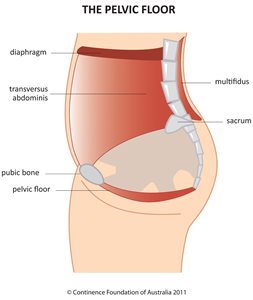The Pelvic Floor Muscles

The muscles that make up your pelvic floor provide support for your pelvic organs and help maintain continence of your bladder and bowel. The pelvic floor muscles are frequently weakened by pregnancy and childbirth and they require special attention during this time.
Pelvic floor muscle weakness can result from:
-
lack of use
-
the weight of the baby on the muscles in pregnancy
-
stretching of the muscles during childbirth
-
regularly straining to use the bowels
-
pushing, or straining to finish emptying the bladder
-
lots of heavy lifting
-
carrying extra weight
The muscles may continue to weaken as a woman ages and experiences the hormonal changes of menopause. This means that minor problems that start after childbirth may progressively worsen with age.
Find out more on your pelvic floor from our e-booklet The Pregnancy and Postnatal Pelvic Floor Connection . .jpg.aspx)
Did you know ....
The Continence Foundation of Australia statistics reveal that:
-
1 in 3 women who have had children will experience some degree of poor bladder control after childbirth, or around menopause
-
64% of pregnant women experience incontinence of urine
-
47% of women may experience urine leakage during exercise, or while playing sport.
One survey of 1505 women showed that:
-
At three months post partum, 34.3% admitted to some degree of urinary incontinence
-
8.5% needed to wear a pad for their incontinence.
Of those in this survey who had just had their first baby:
-
62.6% reported their incontinence began during pregnancy
-
17.6% reported it started after childbirth
-
19.4% had urine leakage before pregnancy.
Of all 1505 women surveyed:
-
only 16.9% did daily pelvic floor muscle exercises during pregnancy
-
only 14.9% did daily pelvic floor muscle exercises at 3 months post partum.
In one study:
-
78.5% were unable to properly contract their pelvic floor muscles one year after having a baby.
-
Many pregnant women incorrectly believed incontinence was a transient problem, caused by giving birth, that would correct itself.
Many people are unaware of how to correctly exercise the pelvic floor muscles.
The booklet, As Your Shape Changes, will help you to become more aware of your muscles, enable you to check that you are doing the exercises correctly and help you know when to seek the advice and assistance of your Physiotherapist.
So, just what are the benefits of performing pelvic floor muscle exercise during pregnancy?
-
Daily pelvic floor exercises during pregnancy reduce the risk of urinary incontinence.
-
Exercising the pelvic floor muscles regularly during pregnancy makes it easier to contract and tighten the muscles after childbirth.
-
The stronger the pelvic floor muscles during and after pregnancy, and the better the pelvic floor muscles are working, the less the risk of stress incontinence, which is leakage of urine during a cough, sneeze, laugh, movement, lifting, sport, or exercise.
What is the role of pelvic floor exercises after childbirth?
-
Starting pelvic floor exercises within the first few days after childbirth will help the muscles to recover more quickly. Even women who have had stitches can do pelvic floor exercises.
-
The condition of the pelvic floor muscles during and after pregnancy affects the life long health of a woman. Studies have shown that women who are unaware of their pelvic floor muscles, or who do not exercise them, are more likely to experience problems in future life.
Does sport have any effect on the pelvic floor muscles?
-
Women may incorrectly believe their sport and other high impact exercise is taking care of their pelvic floor muscles. Participating in sport, running or other high impact activities during pregnancy and early after childbirth may actually reduce pelvic floor muscle strength and cause long-term bladder and bowel problems. These physical problems may include the risk of pelvic organ prolapse requiring surgical repair.
As Your Shape Changes contains valuable advice and a checklist that should be used to determine readiness to return to sport and high impact exercise after childbirth.
For further information read our Postnatal Exercise Guidelines.
The Effects of Childbirth on Your Bowels
It is not often that we stop to talk about our bowel habits with other people; so, how do you know what you experience is normal? Many women have, in fact, grown up with bowel habits that are not normal. Regularly straining to use the bowels, even just a small amount, can weaken the muscles that make up your pelvic floor. The hormonal changes and stretching associated with pregnancy and childbirth also weakens these muscles.
The weakened pelvic floor muscles may not work properly when you empty your bowels. Some women with weakened pelvic floor muscles experience pain or difficulty in using the bowels, which results in straining. The effect of straining actually weakens the pelvic floor muscles even more, further increasing the need to strain. It's a vicious cycle!
Over time, the weakened pelvic floor can lead to leakage of urine (also known as incontinence) Prolapse (where your pelvic organs drop down or feel like they are falling out) is also much more common in women who strain to use their bowels. Samantha's Story gives an account of what can happen over time as a result of straining and a weakened pelvic floor.
The booklet, As Your Shape Changes contains valuable information and advice for women to consider before, during and after pregnancy to help prevent the physical problems often associated with pregnancy and childbirth.
Click here to download a free factsheet called "About pelvic floor muscles"
Pelvic floor diagram reproduced with kind permission from The Continence Foundation of Australia.
Copyright 2011-2020. Demac Resources Pty Ltd. www.thepregnancycentre.com.au